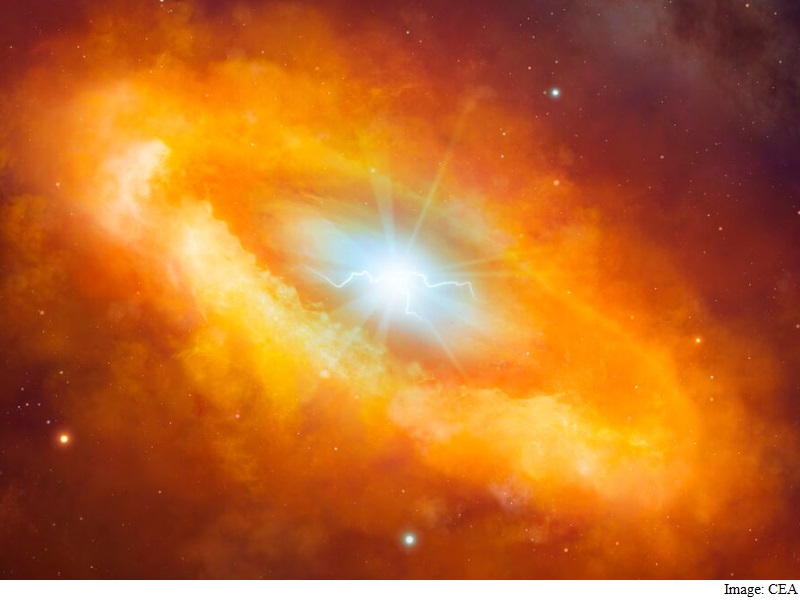- Home
- Science
- Science News
- Source of Unprecedented Energy Found at Centre of Milky Way
Source of Unprecedented Energy Found at Centre of Milky Way

The source was revealed after a detailed analysis of the data collected by the H.E.S.S. observatory in Namibia, which was published in the latest issue of the journal Nature.
H.E.S.S. observatory is being run by an international collaboration of 42 institutions in 12 countries and has been mapping the centre of our galaxy in very high energy gamma rays for over the past 10 years.
"Somewhere within the central 33 light years of the Milky Way there is an astrophysical source capable of accelerating protons to energies of about one petaelectronvolt, continuously for at least 1,000 years," said Emmanuel Moulin from the Saclay Nuclear Research Centre in France.
Cosmic rays with energies up to approximately 100 teraelectronvolts (TeV)1 are produced in our galaxy by objects such as supernova remnants and pulsar wind nebulae.
Theoretical arguments and direct measurements of cosmic rays reaching the Earth indicate, however, that the cosmic-ray factories in our galaxy should be able to provide particles up to one petaelectronvolt (PeV)2 at least.
While many multi-TeV accelerators have been discovered in recent years, the search for the sources of the highest energy Galactic cosmic rays has been unsuccessful.
The electrically-charged cosmic rays are strongly deflected by the interstellar magnetic fields that pervade our galaxy. Their path through the cosmos is randomised by these deflections, making it impossible to directly identify the astrophysical sources responsible for their production.
Thus, for more than a century, the origin of the cosmic rays has remained one of the most enduring mysteries of science.
In analogy to the "Tevatron" the first human-built accelerator that reached energies of 1 TeV this new class of cosmic accelerator has been dubbed a "Pevatron."
Get your daily dose of tech news, reviews, and insights, in under 80 characters on Gadgets 360 Turbo. Connect with fellow tech lovers on our Forum. Follow us on X, Facebook, WhatsApp, Threads and Google News for instant updates. Catch all the action on our YouTube channel.
Related Stories
- Samsung Galaxy Unpacked 2025
- ChatGPT
- Redmi Note 14 Pro+
- iPhone 16
- Apple Vision Pro
- Oneplus 12
- OnePlus Nord CE 3 Lite 5G
- iPhone 13
- Xiaomi 14 Pro
- Oppo Find N3
- Tecno Spark Go (2023)
- Realme V30
- Best Phones Under 25000
- Samsung Galaxy S24 Series
- Cryptocurrency
- iQoo 12
- Samsung Galaxy S24 Ultra
- Giottus
- Samsung Galaxy Z Flip 5
- Apple 'Scary Fast'
- Housefull 5
- GoPro Hero 12 Black Review
- Invincible Season 2
- JioGlass
- HD Ready TV
- Laptop Under 50000
- Smartwatch Under 10000
- Latest Mobile Phones
- Compare Phones
- Redmi Note 15 5G
- Redmi Note 15 Pro 5G
- Redmi Note 15 Pro+ 5G
- Lava Play Max
- Poco C85 5G
- Honor Magic 8 Lite
- Jolla Phone
- Realme P4x 5G
- Asus ProArt P16
- MacBook Pro 14-inch (M5, 2025)
- OnePlus Pad Go 2
- Poco Pad M1
- Just Corseca Skywatch Pro
- Honor Watch X5
- Acerpure Nitro Z Series 100-inch QLED TV
- Samsung 43 Inch LED Ultra HD (4K) Smart TV (UA43UE81AFULXL)
- Asus ROG Ally
- Nintendo Switch Lite
- Haier 1.6 Ton 5 Star Inverter Split AC (HSU19G-MZAID5BN-INV)
- Haier 1.6 Ton 5 Star Inverter Split AC (HSU19G-MZAIM5BN-INV)

















